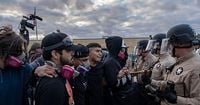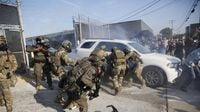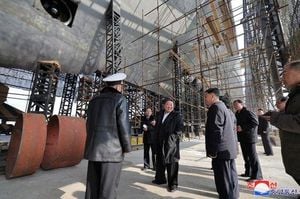On a tense October weekend in Broadview, Illinois, the small suburb west of Chicago became the epicenter of a national debate over immigration, protest rights, and law enforcement tactics. What began as a series of demonstrations against the U.S. Immigration and Customs Enforcement (ICE) facility there escalated into confrontations, arrests, and a swirl of political and ethical controversy that drew in local officials, federal agencies, clergy, and activists from across the ideological spectrum.
According to reports from NPR and Fox News, the protests outside the Broadview ICE facility intensified over several weeks, culminating in a particularly volatile standoff on Saturday, October 11, 2025. Illinois State Police, clad in riot helmets and wielding wooden batons, declared the gathering an unlawful assembly and moved in to disperse the crowd. Clashes erupted as officers advanced, resulting in the detention of several protesters. By evening, at least 15 people had been arrested, as confirmed by multiple outlets including NewsNation and Fox News.
The crackdown followed the imposition of a new curfew by Broadview’s mayor, Katrina Thompson, who restricted protest hours to between 9 a.m. and 6 p.m. In an interview with NewsNation, Mayor Thompson acknowledged the difficulty of her decision, saying, “I’m in a position that every decision that I have to make, people are not going to like.” She explained that all-night protests were disrupting the quality of life for local residents living across the street from the industrial area that houses the ICE facility. “This new rule gave the ISP the pretext to clear out protests on Saturday evening,” reported NewsNation.
The response to the curfew was swift and passionate. Dr. Alli Muhammad, representing the Revolutionary Black Panther Party, voiced the frustration of many activists: “We’re agitated by this restriction, by the way. We feel that the mayor of Broadview, she considers herself an ally, but we’re not comfortable with this 9 to 6 curfew, so we’re going to present this cease and desist to remove the curfew.” By 7 p.m., however, the protest crowd had thinned to only a handful, suggesting that the combination of police presence and municipal restrictions had a chilling effect on the demonstration.
The unrest in Broadview did not occur in a vacuum. The protests coincided with the Trump administration’s “Operation Midway Blitz,” a federal initiative aimed at bolstering immigration enforcement in the Midwest. Chief Border Patrol agent Gregory Bovino, in an interview on Fox & Friends Weekend on October 12, criticized Chicago’s leaders for their “misplaced priorities” amid what he described as escalating anti-ICE protests and growing threats against federal agents. Bovino’s comments underscored the federal government’s hardline stance and the heightened scrutiny on local officials perceived as insufficiently supportive of ICE operations.
Amid these charged confrontations, a particularly notable incident occurred on September 26, 2025, when the Department of Homeland Security (DHS) arrested Elias Cepeda, a journalist and Northeastern Illinois University English professor, outside the Broadview ICE facility. According to the official DHS statement, Cepeda was apprehended while carrying a loaded firearm and four magazines. The Bureau of Alcohol, Tobacco, Firearms and Explosives (ATF) seized the weapon, and DHS described Cepeda as a “violent agitator” with alleged ties to Antifa. Under Secretary Tricia McLaughlin stated, “Violent individuals like Cepeda are putting the public and our law enforcement’s lives in danger. Just two days after the horrific attack on ICE in Dallas, Cepeda brought a loaded gun and multiple magazines to our ICE Broadview facility. Thank God law enforcement intervened and arrested Cepeda before he could have potentially shot or killed anyone.”
The DHS release further alleged that Cepeda’s social media activity glorified violence against federal law enforcement and compared ICE to Nazis. The university, for its part, has not issued any public comment regarding the arrest. The incident heightened concerns about the potential for violence at protests and was cited by Trump administration officials as justification for a robust law enforcement response. “Let this serve as a stark warning to any individual who wishes to do our law enforcement harm or any ANTIFA terrorist: President Trump and Secretary Noem will fight every day to protect and defend the men and women who keep our country safe from violent extremists and criminal illegal aliens alike,” the DHS statement read.
Federal agents, facing hundreds of protesters blocking access to the ICE processing center, responded with pepper ammunition and tear gas. At least two people, including Cepeda, were arrested that day. The use of crowd-control measures like pepper balls, tear gas, flashbangs, and rubber bullets drew sharp criticism from civil liberties advocates and faith leaders alike.
On October 9, a federal judge in Illinois issued a temporary restraining order prohibiting federal agents from using certain crowd control methods against journalists, protesters, and clergy. This legal intervention came after weeks of reports that ICE agents had targeted not only demonstrators but also members of the clergy with aggressive tactics. Reverend Quincy Worthington, a Presbyterian minister from Highland Park, spoke to NPR about his experiences at the protests. “When I first started going, it was to liaison between police and protesters to make sure that everybody was safe, that there were open lines of communication between law enforcement and the protesters so everybody could exercise their First Amendment rights peacefully,” Worthington explained. He described witnessing a steady escalation in ICE’s response: “At first, they would come out of the gates, shove people to the ground, push people out of the way in order to make room for vehicles to enter and exit the facility. Then it started turning into, they would shoot pepper balls at us, and then tear gas started coming out, and then flashbangs and rubber bullets. I have not seen anything that I thought would provoke this response.”
Worthington went further, calling the situation a “humanitarian crisis” and condemning the use of scripture by federal authorities to justify harsh enforcement. “To use scripture in order to promote domination and dehumanization, I find, is probably one of the most egregious and abhorrent uses of scripture that one can do,” he said. He emphasized that faith, for him, means responding with compassion to unnecessary human suffering, regardless of one’s views on immigration policy.
The protests in Broadview have thus become a flashpoint for broader national debates: the limits of protest, the tactics of law enforcement, the responsibilities of local officials, and the ethical dimensions of immigration enforcement. With arrests, legal battles, and public statements flying from all sides, the story is far from over. As the dust settles, the questions raised in Broadview will continue to reverberate far beyond the quiet streets of this Illinois suburb.






